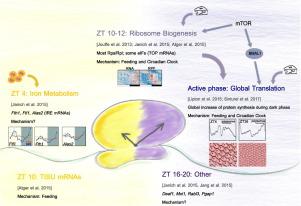当前位置:
X-MOL 学术
›
J. Mol. Biol.
›
论文详情
Our official English website, www.x-mol.net, welcomes your feedback! (Note: you will need to create a separate account there.)
Emerging Roles of Translational Control in Circadian Timekeeping.
Journal of Molecular Biology ( IF 5.6 ) Pub Date : 2020-04-01 , DOI: 10.1016/j.jmb.2020.03.023 Violeta Castelo-Szekely 1 , David Gatfield 1
Journal of Molecular Biology ( IF 5.6 ) Pub Date : 2020-04-01 , DOI: 10.1016/j.jmb.2020.03.023 Violeta Castelo-Szekely 1 , David Gatfield 1
Affiliation

|
A large part of mammalian physiology and behaviour shows regular daily variations. This temporal organisation is driven by the activity of an endogenous circadian clock, whose molecular basis consists of diurnal waves in gene expression. Circadian transcription is the major driver of these rhythms, yet post-transcriptional mechanisms, some of which occur in response to systemic cues and in a tissue-specific fashion, have central roles in ultimately establishing the oscillatory gene expression programme as well. Regulatory control that occurs at the level of translation is emerging as an important player in the generation and modulation of protein accumulation rhythms. As a mechanism, translation lies at a privileged position to integrate genetically encoded rhythmic signals with other, external and internal stimuli, including nutrient-derived cues. In this review, we summarise our current knowledge of how diurnal control of translation affects both bulk protein levels and gene-specific protein biosynthesis. We discuss mechanisms of regulation, in particular with regard to the complex interplay between circadian cycles and feeding/fasting cycles, as well as emerging roles for upstream open reading frames in clock control.
中文翻译:

翻译控制在昼夜节律中的新兴作用。
很大一部分哺乳动物的生理和行为表现出规律的每日变化。这种时间组织是由内源性生物钟的活动驱动的,该生物钟的分子基础由基因表达中的昼夜波组成。昼夜节律的转录是这些节律的主要驱动力,但是转录后的机制在最终建立振荡基因表达程序中也起着核心作用,转录后的机制中的一些响应于系统性提示并以组织特异性方式发生。在翻译水平上发生的调节控制正在成为蛋白质积累节奏的产生和调节中的重要角色。作为一种机制,翻译处于特权位置,可以将基因编码的节奏信号与其他,内部和外部刺激(包括营养来源的提示)整合在一起。在这篇综述中,我们总结了目前对翻译的昼夜控制如何影响大量蛋白质水平和基因特异性蛋白质生物合成的知识。我们讨论调节的机制,特别是关于昼夜节律与进食/禁食周期之间的复杂相互作用,以及上游开放阅读框在时钟控制中的新兴作用。
更新日期:2020-04-01
中文翻译:

翻译控制在昼夜节律中的新兴作用。
很大一部分哺乳动物的生理和行为表现出规律的每日变化。这种时间组织是由内源性生物钟的活动驱动的,该生物钟的分子基础由基因表达中的昼夜波组成。昼夜节律的转录是这些节律的主要驱动力,但是转录后的机制在最终建立振荡基因表达程序中也起着核心作用,转录后的机制中的一些响应于系统性提示并以组织特异性方式发生。在翻译水平上发生的调节控制正在成为蛋白质积累节奏的产生和调节中的重要角色。作为一种机制,翻译处于特权位置,可以将基因编码的节奏信号与其他,内部和外部刺激(包括营养来源的提示)整合在一起。在这篇综述中,我们总结了目前对翻译的昼夜控制如何影响大量蛋白质水平和基因特异性蛋白质生物合成的知识。我们讨论调节的机制,特别是关于昼夜节律与进食/禁食周期之间的复杂相互作用,以及上游开放阅读框在时钟控制中的新兴作用。



























 京公网安备 11010802027423号
京公网安备 11010802027423号